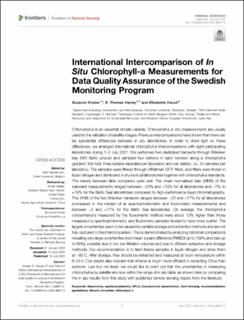| dc.contributor.author | Kratzer, Susanne | |
| dc.contributor.author | Harvey, E. Therese | |
| dc.contributor.author | Canuti, Elisabetta | |
| dc.date.accessioned | 2022-09-21T09:29:43Z | |
| dc.date.available | 2022-09-21T09:29:43Z | |
| dc.date.created | 2022-08-23T11:04:52Z | |
| dc.date.issued | 2022 | |
| dc.identifier.citation | Frontiers in Remote Sensing. 2022, 3, 866712. | en_US |
| dc.identifier.issn | 2673-6187 | |
| dc.identifier.uri | https://hdl.handle.net/11250/3020135 | |
| dc.description.abstract | Chlorophyll-a is an essential climate variable. Chlorophyll-a in situ measurements are usually used for the validation of satellite images. Previous intercomparisons have shown that there can be substantial differences between in situ laboratories. In order to shed light on these differences, we arranged international chlorophyll-a intercomparisons with eight participating laboratories during 1–2 July 2021. We performed two dedicated transects through Bråviken bay (NW Baltic proper) and sampled four stations in each transect along a chlorophyll-a gradient. We took three surface replicates per laboratory and per station, i.e., 24 samples per laboratory. The samples were filtered through Whatman GF/F filters, and filters were frozen in liquid nitrogen and distributed in dry ice to all laboratories together with chlorophyll-a standards. The results between labs compared quite well. The mean normalized bias (MNB) of the standard measurements ranged between −23% and +19% for all laboratories and −7% to +19% for the Baltic Sea laboratories compared to high-performance liquid chromatography. The MNB of the two Bråviken transects ranged between −23 and +17% for all laboratories (compared to the median of all spectrophotometric and fluorometric measurements) and between −2 and +17% for the Baltic Sea laboratories. On average, the chlorophyll-a concentrations measured by the fluorometric method were about 13% higher than those measured by spectrophotometry, and fluorometry samples tended to have more scatter. The largest uncertainties seem to be caused by variable storage and extraction methods and are not fully captured in this intercomparison. This is demonstrated by analyzing historical comparisons revealing very large uncertainties (root mean square difference (RMSD) up to 109% and bias up to 68%), possibly due to too low filtration volumes and due to different extraction and storage methods. Our recommendation is to flash-freeze samples in liquid nitrogen and store them at −80°C. After storage, they should be extracted and measured at room temperature within 6–24 h. Our results also indicate that ethanol is much more efficient in extracting Chl-a than acetone. Last but not least, we would like to point out that the uncertainties in measuring chlorophyll-a by satellite are now within the range of in situ data, as shown here by comparing the in situ results from this study with published remote sensing results from the literature. | en_US |
| dc.language.iso | eng | en_US |
| dc.publisher | Frontiers | en_US |
| dc.rights | Navngivelse 4.0 Internasjonal | * |
| dc.rights.uri | http://creativecommons.org/licenses/by/4.0/deed.no | * |
| dc.title | International Intercomparison of In Situ Chlorophyll-a Measurements for Data Quality Assurance of the Swedish Monitoring Program | en_US |
| dc.type | Peer reviewed | en_US |
| dc.type | Journal article | en_US |
| dc.description.version | publishedVersion | en_US |
| dc.rights.holder | Copyright © 2022 Kratzer, Harvey and Canuti | en_US |
| dc.source.pagenumber | 17 | en_US |
| dc.source.volume | 3 | en_US |
| dc.source.journal | Frontiers in Remote Sensing | en_US |
| dc.identifier.doi | 10.3389/frsen.2022.866712 | |
| dc.identifier.cristin | 2045256 | |
| dc.source.articlenumber | 866712 | en_US |
| cristin.ispublished | true | |
| cristin.fulltext | original | |
| cristin.qualitycode | 1 | |

